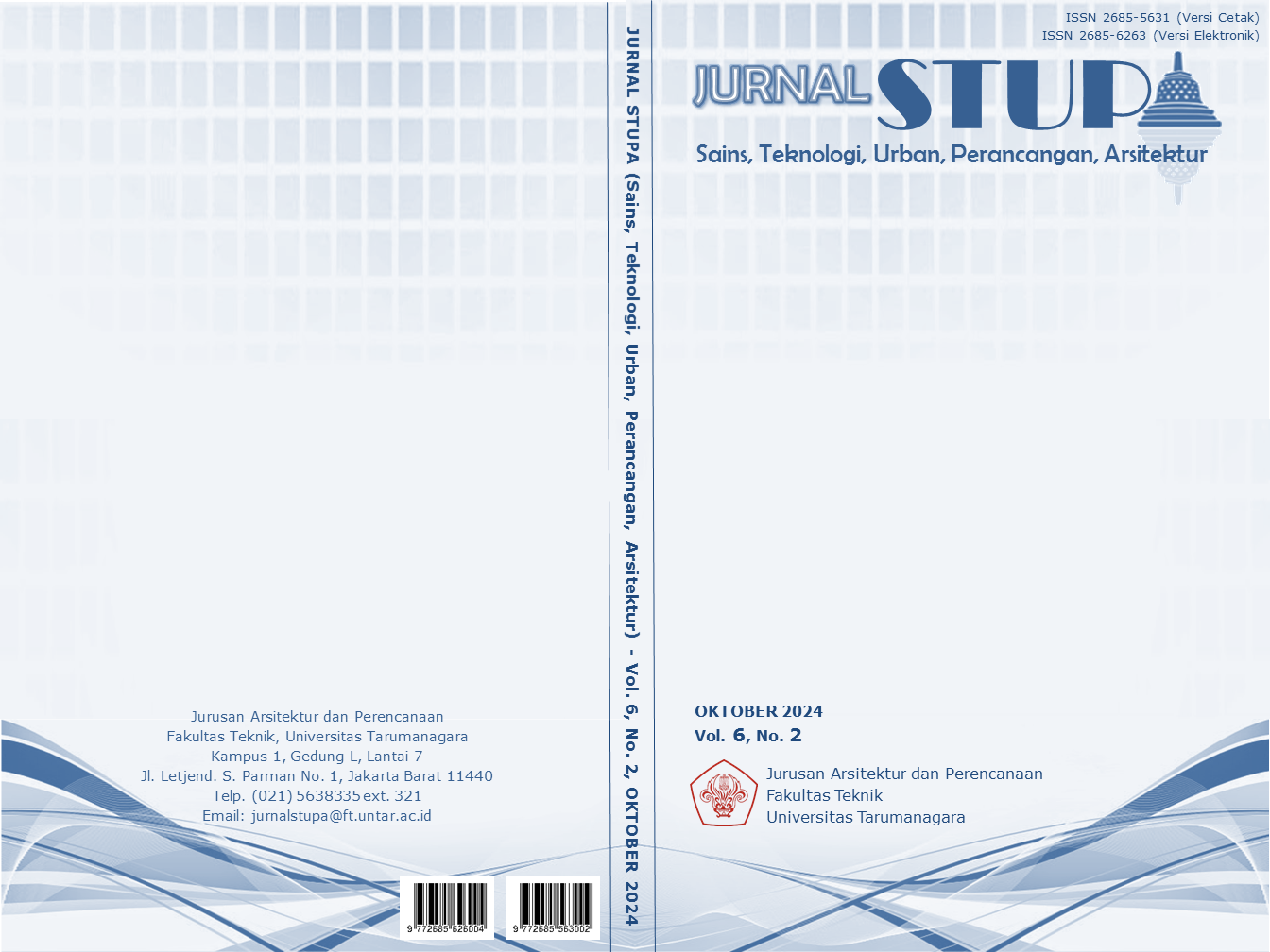PERANCANGAN IDENTITAS TEMPAT PADA SEKOLAH CANDRA NAYA DENGAN PENDEKATAN NARASI ARSITEKTUR
Main Article Content
Abstract
A place will have meaning as a Place, if there is contiguity, uniqueness, and connection both physically and non-physically. In its development, a place can experience degradation from activity or physicality known as Placeless Place. One of the places that experienced this phenomenon was Candra Naya School. At first, the existence of Candra Naya School had existed since 1946 in the Candra Naya Building, but due to changes in land use, Candra Naya School was moved to Jl. Jembatan Besi II. Since its move in 1993 until its current existence, Candra Naya School has lost its authenticity, uniqueness, disconnection with its environment and sense of belonging, making Candra Naya School experience the process of Placeless Place. Referring to this background, there is a problem of how to solve the architectural Placeless Place at Candra Naya School. Therefore, the purpose of this design is to restore the identity, uniqueness, historical ties, and meaning of student life at Candra Naya School. The design approach used is Narrative Architecture through space experience with the stages of Edu-cial, Society-Hub, and Historium activities.Edu-cial is a community-oriented educational space where interaction between students and the community occurs. Society-Hub is a space to accommodate activities and serve the community. And, Historium is a space about the historical journey of Candra Naya School. These stages of activity will become a bond between students, the community, and Candra Naya School so that a Sense of Place is created and becomes a Place again.
Keywords: edu-cial; historium; narrative architecture; placeless place; society-hub
Abstrak
Suatu tempat akan memiliki makna sebagai Place, jika terdapat keontetikan, keunikan, dan koneksi baik secara fisik maupun non fisik. Dalam perkembangannya, tempat dapat mengalami degradasi dari aktivitas atau fisik dikenal dengan istilah Placeless Place. Salah satu tempat yang mengalami fenomena tersebut adalah Sekolah Candra Naya. Pada awalnya, eksistensi Sekolah Candra Naya sudah ada sejak tahun 1946 di Gedung Candra Naya, namun akibat pergantian tata guna lahan membuat Sekolah Candra Naya dipindahkan ke Jl. Jembatan Besi II. Sejak kepindahannya di tahun 1993 hingga eksistensinya saat ini, Sekolah Candra Naya kehilangan keotentikan, keunikan, diskoneksi dengan lingkungannya dan sense of belonging sehingga menjadikan Sekolah Candra Naya mengalami proses Placeless Place. Mengacu pada latar belakang tersebut, terdapat permasalahan bagaimana penyelesaian arsitektural Placeless Place pada Sekolah Candra Naya. Oleh karena itu, tujuan dari desain ini adalah untuk mengembalikan identitas, keunikan, ikatan historis, serta memaknai kehidupan siswa di Sekolah Candra Naya. Pendekatan desain yang digunakan adalah Arsitektur Naratif melalui pengalaman ruang dengan tahapan aktivitas Edu-cial, Society-Hub, serta Historium. Edu-cial merupakan ruang pendidikan yang berorientasi pada masyarakat dimana terjadi interaksi antara siswa dan masyarakat. Society-Hub merupakan ruang untuk mewadahi kegiatan serta melayani masyarakat. Serta, Historium merupakan ruang tentang perjalanan sejarah Sekolah Candra Naya. Tahapan aktivitas ini akan menjadi pengikat antar siswa, masyarakat, dan Sekolah Candra Naya itu sehingga terciptanya Sense of Place dan menjadi Place kembali.
Article Details

This work is licensed under a Creative Commons Attribution-NonCommercial-ShareAlike 4.0 International License.
This work is licensed under a Jurnal Sains, Teknologi, Urban, Perancangan, Arsitektur/ STUPA Creative Commons Attribution-NonCommercial-ShareAlike 4.0 International LicenseReferences
Coates, N. (2012). Narrative architecture. John Wiley & Sons.
Dewantara, K. H. (1962). Bagian I Pendidikan. Yogyakarta: Majelis Luhur Persatuan Taman Siswa.
Kementerian Pendidikan, K. R.. Karakteristik Kurikulum Merdeka. Retrieved from Kurikulum Merdeka : https://kurikulum.kemdikbud.go.id/
Marc, A., and MACKIAN, S. (1995). Non-places: Introduction to an anthropology of supermodernity: From places to non-places. Verso.
Menteri Pendidikan, K. R. (2023). PERMENDIKBUD No. 22 Tahun 2023 Tentang Standar Sarana dan Prasarana pada Pendidikan Anak Usia Dini, Jenjang Pendidikan Dasar, dan Jenjang Pendidikan Menengah.
Permendikbudristek Nomor 47 Tahun 2023 . (n.d.). Jakarta: Kementerian Pendidikan, Kebudayaan, Riset, dan Teknologi Republik Indonesia.
Psarra, S. (2009). Architecture and Narrative: The formation of space and cultural meaning. Routledge.
Relph, E. (1976). Place and placelessness. Pion Limited.
Tissink, F. E. (2016). Narrative-driven design (Doctoral dissertation, Master thesis. TU Delft.
Tuan, Y. F. (1977). Space and place: The perspective of experience. U of Minnesota Press.
Undang-Undang Republik Indonesia Nomor 20 Tahun 2003 tentang Sistem Pendidikan Nasional. Jakarta, Indonesia.
Widayati, N. (2003). CANDRA NAYA ANTARA KEJAYAAN MASA LALU DAN KENYATAAN SEKARANG (Hasil Penelitian tahun 1994-1998). DIMENSI (Journal of Architecture and Built Environment), 31(2).
Wiji, S. (2017). Dasar-dasar Ilmu Pendidikan. Jakarta : Kencana Prenada Media Group.



